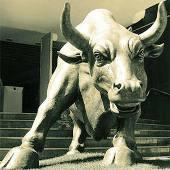 In theory, investment is a zero-sum game with all losses and gains balanced. In a stock transaction where the price rises, the seller's loss is equivalent to buyer's gain.
In theory, investment is a zero-sum game with all losses and gains balanced. In a stock transaction where the price rises, the seller's loss is equivalent to buyer's gain.
If the price drops, the buyer's loss equals seller's gain. If the price is unchanged, the buyer suffers (theoretical) opportunity loss since he forgoes potential profits elsewhere. This is equal to the seller's theoretical opportunity gain.
In short-term trades, there are few complications in these calculations. But in a long-term investment scenario, both parties may gain in effect. For example, assume X bought stock A 12 months ago. X sold A to Y and booked a profit of 50 per cent, six months ago. A has appreciated 100 per cent, with a 33 per cent gain since X made an exit.
X made cash-profits of 50 per cent, followed by opportunity loss of 33 per cent. Y's gain of 33 per cent is equal to X's opportunity loss. But X could have found alternate investments worth 33 per cent or higher since the exit. Of course, the flipside occurs when price drops and everyone loses.
It is easier to compare risks and rewards for short-term trades than for long-term investments. A short-term trade usually has higher risks but these are transparent. A long-term investment is more difficult to evaluate because there are more alternatives to compare with.
Both traders and investors need to set limits. Traders' limits are cut-and-dried. Disciplined traders will set stop losses for themselves. Or else, the market sets it via margin calls. Time limits on trades are also set by the need to settle margined positions.
An investor needs to set limits for both time and price. For example, he may decide to give an ailing business two quarters to turnaround. Then he must prepare to wait six months and withstand possible capital losses in that time. He may actually increase exposure and average down. If he is wrong on the turnaround, or doesn't wait long enough, the losses may be very substantial.
The BuffettGraham school introduces discipline by a focus on stable predictable businesses in the case of Buffett, and on low valuations in the case of Graham. Followers of the value-oriented, growth-investing Gurus are rarely massively in the red.
Unfortunately this style of investing is very restrictive. Apart from the old faithfuls of the FMCG sector, there aren't too many industries offering stable predictable returns and FMCG is usually priced fairly high.
Almost every other industry offers low valuations once in a while but most other industries also have highly cyclical features. Most of the big Indian success stories of the recent past have actually been cyclicals. These include IT in the late 1990s, infrastructure, and real estate in the mid-2000s.
The returns (and losses for those who mistimed) from cyclicals have far exceeded those from stable businesses in the past few years. Since January 2005 for instance, Hind Unilever has returned 38 per cent across almost five years.
Unitech has returned over 1,400 per cent in the same period and that is after a savage correction. No Levers' investor at any time during 2005-2009 would have been a major loser. Those who bought Unitech at its peak in mid-2007, have so far, lost 85 per cent.
Decoding cyclicality is a fascinating game. It can be very rewarding but as the above shows, also very risky. In one sense, a cyclical investor is a long-term trader since he tries to enter during troughs and exit near peaks, rather than buy-and-hold forever.
The period since March 2009 has been confusing. In March 2009, most stocks were very reasonably valued but there was little clarity on the time-frame of turnarounds. Now, turnarounds appear to be in sight in many instances but valuations are on the high side.
The market peaked at a Nifty PE 23+ (last four quarters) in mid October and has since eased to a recent low of PE 20. Looking forward, a full-fledged cyclical recovery for the macro-economy is probably two or three quarters away and the current scenario doesn't justify PEs higher than 15-16.
The prudent value investor would wait for further corrections. The practical one would note that there aren't many alternative investments looking attractive. So they would invest in moderation now, and be braced to average down if the market falls further.







